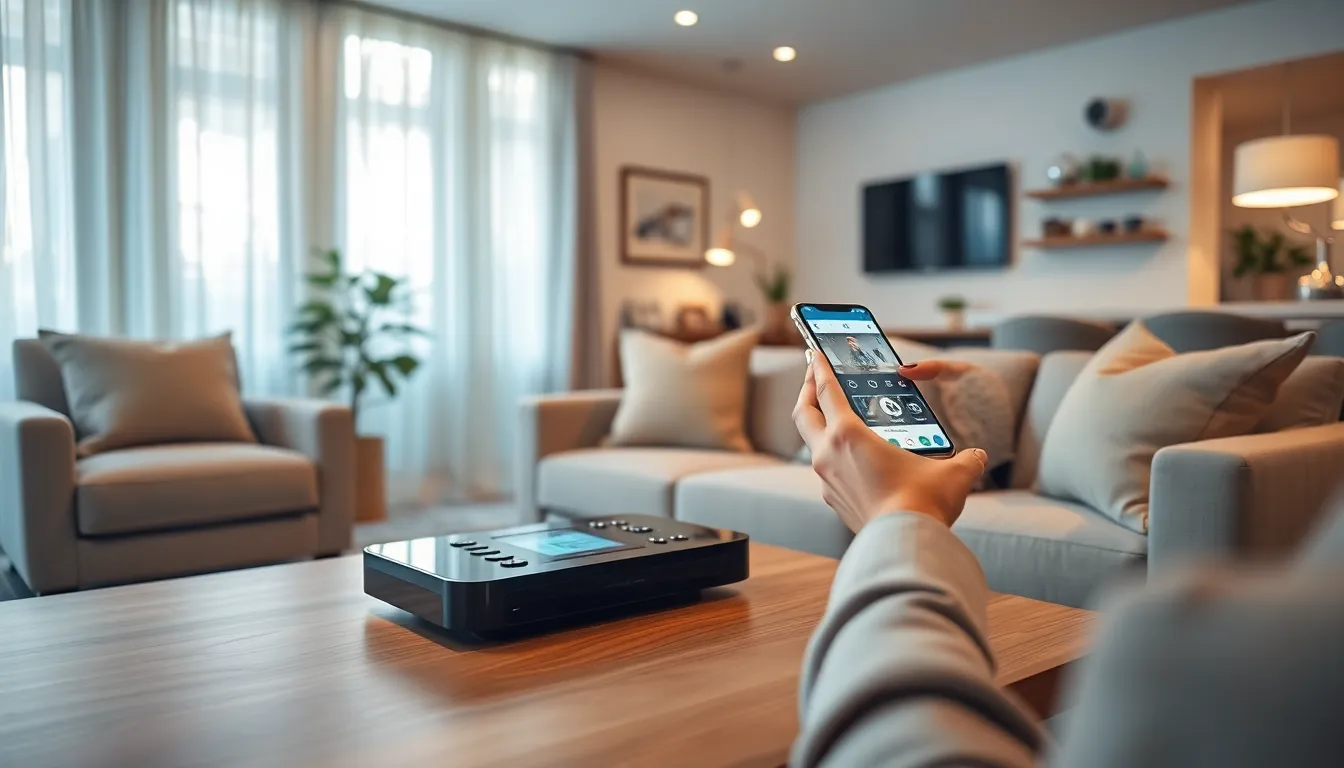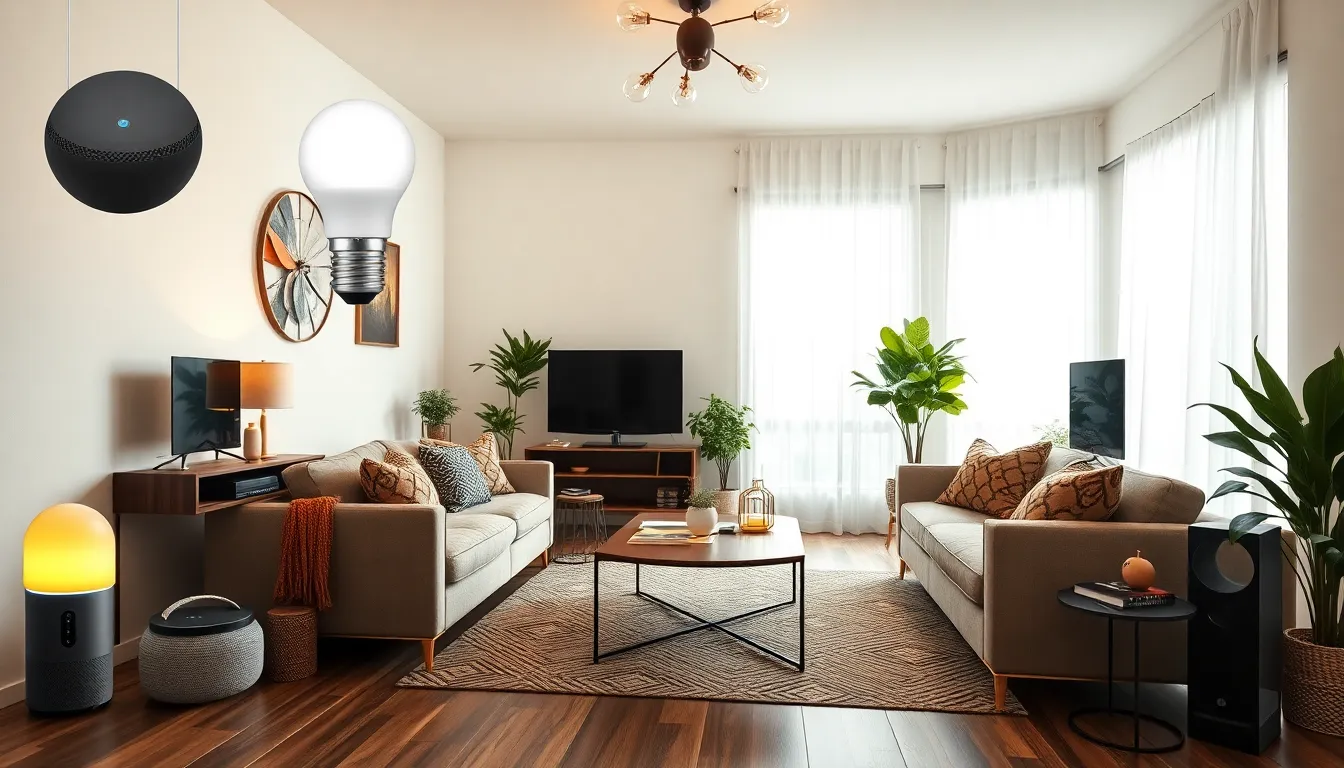Imagine walking into your home and having it greet you like an old friend. With smart home controllers, that dream’s a reality. These nifty gadgets take the chaos out of managing your devices, turning your home into a tech-savvy sanctuary. Who wouldn’t want to control the lights, thermostat, and even the coffee maker with just a tap or a voice command?
Table of Contents
ToggleOverview of Smart Home Controllers
Smart home controllers serve as the central hub for managing connected devices within a home. Users can control lights, thermostats, and security systems through these devices. Controllers enhance convenience and efficiency by enabling automation and remote access.
Many models support voice control through virtual assistants like Amazon Alexa and Google Assistant. Integration with various devices allows for seamless communication between equipment. A wide range of smart home controllers exists, catering to different needs and preferences.
Compatibility stands out as a crucial factor when selecting a smart home controller. Users should verify if the controller can operate with the devices they currently own. Smart home platforms like Apple HomeKit optimize user experience by allowing integration across hardware brands.
Security features play a significant role in smart home controllers. They offer encryption and secure access to protect user data and prevent unauthorized control. Some controllers provide advanced security integrations, including real-time alerts and monitoring capabilities.
Customization offers additional benefits. Users can set routines, such as turning lights on automatically at sunset or adjusting the thermostat based on their schedule. This flexibility enhances energy efficiency and improves overall comfort in the home.
Smart home controllers simplify device management. They provide significant benefits in terms of convenience, security, and customization. As technology evolves, these controllers continue to advance, offering more capabilities and integrations for a better smart home experience.
Types of Smart Home Controllers


Smart home controllers come in various types, each designed to enhance functionality and user experience. Understanding these types helps homeowners select the most suitable option for their needs.
Hub-Based Controllers
Hub-based controllers act as central command centers for smart home devices. These devices connect multiple gadgets regardless of brand, creating an integrated system. Users enjoy the benefit of automating routines, such as setting lights to turn on at sunset or adjusting the thermostat before arriving home. Many hub-based controllers support Zigbee and Z-Wave protocols, ensuring broader compatibility with devices. Notably, examples include SmartThings Hub and Wink Hub, allowing users flexibility and customization for their smart home setup.
Voice Assistant Controllers
Voice assistant controllers utilize built-in virtual assistants, enabling hands-free management of connected devices. Products like Amazon Echo and Google Nest Hub offer seamless integration with various smart devices. Users can control lighting, temperature, and even security systems through simple voice commands. These controllers adapt to voice recognition technology, learning user preferences over time. In addition, they enhance accessibility for individuals with mobility challenges, providing an intuitive interface for managing the home environment.
Smartphone-Based Controllers
Smartphone-based controllers enable users to manage their smart home devices through mobile applications. These apps, available on both Android and iOS, offer user-friendly interfaces for accessing devices from anywhere. For instance, homeowners can monitor security cameras or adjust lighting while away from home. Customization features within these apps allow users to create schedules, set alerts, and receive real-time updates. The convenience of smartphone-based control empowers users with greater flexibility in managing their smart home ecosystems.
Features to Consider
Smart home controllers come with various features that enhance user experience and device management. Understanding these features helps in selecting the right controller.
Compatibility with Devices
Compatibility stands as a crucial aspect of smart home controllers. Users must check whether the controller integrates seamlessly with existing devices, such as lights, thermostats, and security systems. Some controllers work with a wide range of brands, while others may only support specific ones. Platforms like Z-Wave and Zigbee enhance connectivity possibilities. A compatible controller ensures that all devices operate smoothly together.
User Interface and Usability
User interface design significantly affects usability. An intuitive interface simplifies navigation, making it easier for users to manage devices. Touch screens, mobile apps, or voice commands contribute to a user-friendly experience. Controllers that support voice commands allow for hands-free operation, enhancing convenience. A visually appealing layout helps users quickly access essential functions, promoting engagement and satisfaction.
Security and Privacy Features
Security and privacy features cannot be overlooked in smart home controllers. Robust encryption protocols safeguard user data from unauthorized access. Real-time alerts notify users of potential security breaches, providing peace of mind. Regular updates ensure the system remains equipped against emerging threats. User-friendly privacy settings allow individuals to control data sharing, making informed choices about their home network.
Popular Smart Home Controllers
Smart home controllers offer various models with unique features that elevate home automation. Below are some of the most popular options available.
Amazon Echo Plus
Amazon Echo Plus serves as a powerful voice assistant controller. It integrates seamlessly with compatible devices, making it ideal for hands-free management. Users can control lights, thermostats, and more through simple voice commands. The built-in Zigbee hub connects smart devices directly, enhancing interoperability. Alexa skill support allows for increased customization, enabling routines tailored to individual preferences. This model also prioritizes security, utilizing encryption to safeguard personal data.
Google Nest Hub
Google Nest Hub functions as a versatile command center for the smart home. Its touchscreen display provides visual feedback and easy access to various features. Through Assistant, users can manage devices, set reminders, and access entertainment with vocal commands. The Nest Hub integrates well with many brands, allowing for a connected home experience. Additionally, the device showcases a user-friendly interface, making device management straightforward. Privacy controls offer transparency on data usage, reassuring users about their information.
Samsung SmartThings
Samsung SmartThings acts as a central hub for managing a wide range of smart devices. This hub supports multiple protocols, ensuring compatibility with diverse brands. Users can automate tasks by creating customized routines based on their preferences. An intuitive app allows for remote access to devices, enhancing flexibility. SmartThings also incorporates robust security features, including encrypted communication to protect user data. Integration with various sensors further enhances home automation capabilities, catering to specific user needs.


